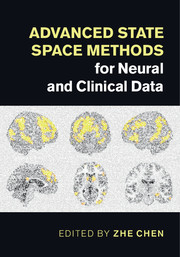Book contents
- Frontmatter
- Contents
- List of contributors
- Preface
- Introduction
- Inference and learning in latent Markov models
- Part I State space methods for neural data
- Part II State space methods for clinical data
- Bayesian nonparametric learning of switching dynamics in cohort physiological time series: application in critical care patient monitoring
- Identifying outcome-discriminative dynamics in multivariate physiological cohort time series
- A dynamic point process framework for assessing heartbeat dynamics and cardiovascular functions
- Real-time segmentation and tracking of brain metabolic state in ICU EEG recordings of burst suppression
- Signal quality indices for state space electrophysiological signal processing and vice versa
- index
- References
A dynamic point process framework for assessing heartbeat dynamics and cardiovascular functions
from Part II - State space methods for clinical data
Published online by Cambridge University Press: 05 October 2015
- Frontmatter
- Contents
- List of contributors
- Preface
- Introduction
- Inference and learning in latent Markov models
- Part I State space methods for neural data
- Part II State space methods for clinical data
- Bayesian nonparametric learning of switching dynamics in cohort physiological time series: application in critical care patient monitoring
- Identifying outcome-discriminative dynamics in multivariate physiological cohort time series
- A dynamic point process framework for assessing heartbeat dynamics and cardiovascular functions
- Real-time segmentation and tracking of brain metabolic state in ICU EEG recordings of burst suppression
- Signal quality indices for state space electrophysiological signal processing and vice versa
- index
- References
Summary
Introduction
Modeling physiological systems by control systems theory, advanced signal processing, and parametric modeling and estimation approaches has been of focal importance in biomedical engineering (Khoo 1999; Marmarelis 2004; Xiao et al. 2005; Porta et al. 2009). In computerized cardiology, various types of data such as the electrocardiogram (ECG), arterial blood pressure (ABP, measured by invasive arterial line catheters or noninvasive finger cuffs), and respiratory effort (RP; e.g., measured by plethysmography or by piezoelectric respiratory belt transducers) are recorded, digitized and saved to a computer to be available for off-line analysis. Modeling autonomic cardiovascular control using mathematical approaches is helpful for understanding and assessing autonomic cardiovascular functions in healthy or pathological subjects (Berntson et al. 1997; Parati et al. 2001; Stauss 2003; Eckberg 2008). Continuous quantification of heartbeat dynamics, as well as their interactions with other cardiovascular measures, have been widely studied in the past decades (Baselli et al. 1988; Saul & Cohen 1994; Chon et al. 1996; Barbieri et al. 2001; Porta et al. 2002).
A central goal in biomedical engineering applied to cardiovascular control is to develop quantitative measures and informative indices that can be extracted from physiological measurements. Assessing and monitoring informative physiological indices is an important task in both clinical practice and laboratory research. Specifically, a major challenge in cardiovascular engineering is to develop statistical models and apply signal processing tools to investigate various cardiovascular-respiratory functions, such as heart rate variability (HRV), respiratory sinus arrhythmia (RSA), and baroreflex sensitivity (BRS). In the literature, numerous methods have been proposed for quantitative HRV analysis (Malpas 2002). Two types of standard methods are widely used, one is time-domain analysis based on heartbeat intervals, the other is frequency-domain analysis (Baselli et al. 1985). In addition, nonlinear system identification methods have also been applied to heartbeat interval analysis (Chon et al. 1996; Christini et al. 1995; Zhang et al. 2004; Xiao et al. 2005). Examples of higher-order characterization for cardiovascular signals include nonlinear autoregressive (AR) models, Volterra–Wiener series expansion, and Volterra–Laguerre models (Korenberg 1991; Marmarelis 1993; Akay 2000).
- Type
- Chapter
- Information
- Advanced State Space Methods for Neural and Clinical Data , pp. 302 - 329Publisher: Cambridge University PressPrint publication year: 2015
References
- 1
- Cited by

